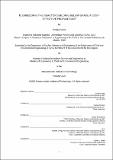Is embedding the reactor building below grade a cost-effective proposition?
Author(s)
Velez, Enrique(Velez Lopez)
Download1237260686-MIT.pdf (7.167Mb)
Other Contributors
Massachusetts Institute of Technology. Department of Civil and Environmental Engineering.
Massachusetts Institute of Technology. Department of Nuclear Science and Engineering.
Advisor
Herbert Einstein and Jacopo Buongiorno.
Terms of use
Metadata
Show full item recordAbstract
The construction cost of reactor buildings has escalated substantially over time primarily for three reasons. First, new safety requirements, such as the post-9/11 airplane crash measures, have been imposed. Second, labor rates for construction workers and the cost of raw materials such as steel for rebar and cement for concrete have increased. Third, the deployment of new plant designs, such as AP1000 (Advanced Pressurized 1000 MWe Reactor) and EPR (European Pressurized Reactor), has been plagued by first-of-a-kind challenges and a general loss of construction know-how by the nuclear industry in the U.S and Western Europe. Embedding the reactor building below grade is a potential approach to reducing the construction cost of new plants, be they large LWRs (Light Water Reactors), SMRs (Small Modular Reactors) or Generation-IV designs. There are important trade-offs. Embedment of a reactor building requires a much larger excavation effort than is necessary for above-grade plants. However, embedded buildings have lower loads during an earthquake or an airplane crash, thus requiring a lot less reinforcement. The cost of the building itself can therefore be significantly lower. In this thesis we analyze various modularized, silo-type reactor buildings (i.e., the type used, for example, in GEH's (General Electric Hitachi) BWRX-300 (Boiling Water Reactor X-300) design) for a set of reference seismic loads at sites with both soil and rock stratigraphy. The comparison includes a completely embedded design, a partially-embedded design and an above-ground design. The level of reinforcement required is determined from FEM (Finite Element Method) analysis of the building, and the cost of constructing the buildings is estimated from productivity data, labor rates and materials costs obtained from industry sources. This leads to the finding that there are some building layouts and sites where there is a potential cost reduction in embedment.
Description
Thesis: M. Eng., Massachusetts Institute of Technology, Department of Civil and Environmental Engineering, September, February, 2020 Thesis: S.M., Massachusetts Institute of Technology, Department of Nuclear Science and Engineering, February, 2020 Cataloged from student-submitted PDF of thesis. Includes bibliographical references (pages 103-105).
Date issued
2020Department
Massachusetts Institute of Technology. Department of Civil and Environmental Engineering; Massachusetts Institute of Technology. Department of Nuclear Science and EngineeringPublisher
Massachusetts Institute of Technology
Keywords
Civil and Environmental Engineering., Nuclear Science and Engineering.